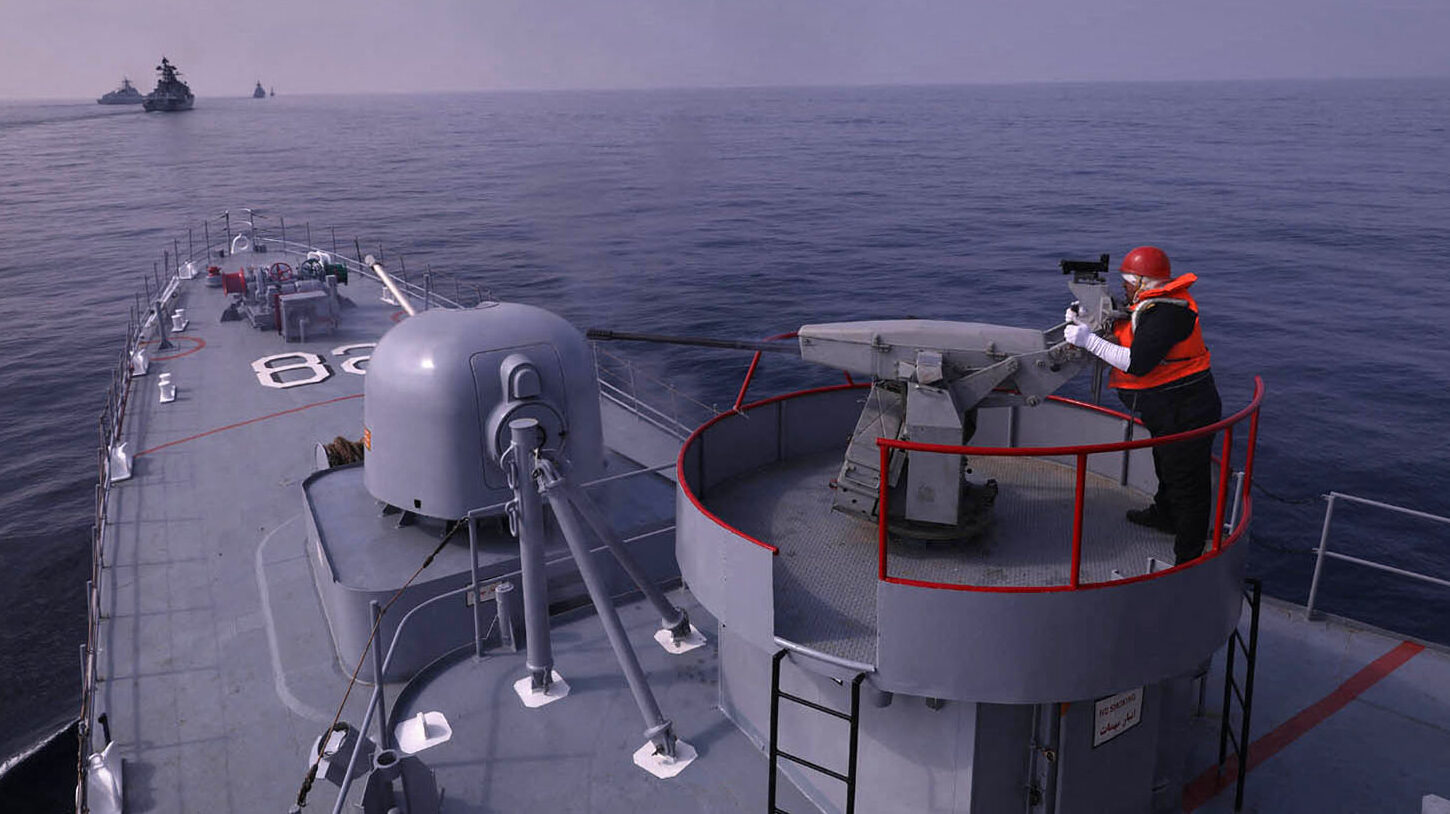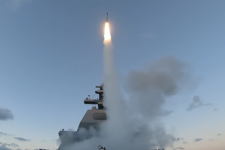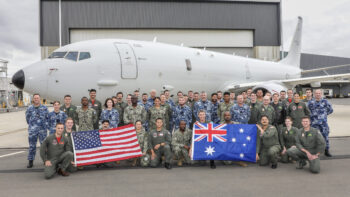
A handout picture made available by the Iranian Army official website on January, 21 2022 shows a navy-man firing atop a warship during a joint military drill in the Indian ocean. Iran, Russia and China will began today joint naval drills for three days in the Indian Ocean, seeking to reinforce “common security”, an Iranian naval official said. (Iranian Army office/AFP via Getty Images)
TEL AVIV — In addition to its nuclear and long-range ballistic missiles program, Iran has for years been working to build up its navy, with the goal of being able to project power in its surrounding bodies of water. Now, Israeli defense sources warn, Tehran is looking to lean on its increased ties with Russia to add new ships to its fleet.
However, experts warn that internal politics between the Islamic Revolutionary Guard Corps (IRGC) and the domestic navy may complicate any effort between Tehran and Moscow to work together on naval capabilities.
According to multiple Israeli defense sources, officials from Iran have traveled to Russia to discuss the potential for naval cooperation. They carried with them two requests, Israeli sources say: first, to buy some existing Russian warships, and then to ask the Russians to design more bespoke naval capabilities that fit with Iran’s operational requirements. (Russia already has some ship designs built for export, including the Grigorovich-class, classified as a “general purpose” surface combat vessel.)
It is highly unlikely Iran would build these ships themselves, given resource constraints. Instead, whatever comes from the agreement would be built in Russia. It is expected that both the new designs and the existing ones would be outfitted with versions of Iran’s homemade cruise missiles.
“The Iranians hoped that China [would] help them to build a navy but the Chinese were not in a hurry to share their maritime technologies,” Eliezer Marom, former commander of the Israeli navy, told Breaking Defense. “The war in Ukraine opened a new option to acquire the needed combat vessels from Russia.”
It’s not the first tie between Russia and Iran on the sea, as the Russian navy has been instrumental in helping Iran ship oil to Syria. According to a report from the US Naval Institute, in October the Iranian-flagged oil tanker Samah entered the Mediterranean Sea via the Suez Canal. “After a few miles, the 900-foot-long ship stopped reporting its position and destination. Evidence suggests the ship sailed to Syria, escorted by two Russian Navy ships, including a destroyer,” the report states.
RELATED: Kahl to Gulf states: Why work with Russia when it is funding Iran?
Iran’s maritime aspirations became clear some years ago when its officials for the first time pointed to the plan to establish a naval station in Syria, to be able to support Hezbollah on a regular basis without having to rely on air or land convoys through Syria, Iraq, or Turkey. The plan included the opening of another naval station in Yemen, through which Iran will be able to pose a threat at the Red Sea’s entrance and potentially impede ship traffic heading towards the Suez Canal and the Gulf of Eilat. (As a bonus, Israeli sources believe that such a station would also help Iran with intelligence gathering.)
Those two naval stations were not officially established, but in recent years the Iranian navel plan became even more ambitious — to potentially include expanding beyond its territorial waters.
According to Iranian Navy Commander Rear Adm. Shahram Irani, Iranian naval units are now present in the Indian Ocean, the Atlantic Ocean as well as the Pacific Ocean, and are safeguarding merchant containers and oil tankers owned or leased by the Islamic Republic during their missions in international waters.
Iran is also building relations with Venezuela, with Israeli intelligence concluding that the latter may allow Iranian naval forces to use its ports in the future — giving Iran a naval base to operate out of in the Americas.
Israeli naval expert Shaul Chorev told Breaking Defense that the plan to create an Iranian naval presence in the western hemisphere is largely an effort to “poke a finger in the west’s eye.”
Chorev, a former deputy chief of the Israeli Navy, also served from 2007 to 2015 as the head of the Israel Atomic Energy Commission. He noted that the Iranian plan to expand the presence of their navy became clear when they participated in an exercise with the Russian fleet and two of their ships arrived at St. Petersburg this February.
“The new defense relations with Russia may help” Iran build up its navy, Chorev said. “The Iranian IRCG are operating small vessels that are used to attack mostly civil ships in the region. The current effort is to build a real capable navy.”
Complicating Factors
One major question about any naval buildup, however, is who gets what. The IRGC acts as effectively an independent military, with few ties between its operations or acquisitions and that of Iran’s regular navy. And their different mission sets require different capabilities.
A good example to that came in May, when the IRGC navy expanded its fleet with three new military ships, including a patrol combat boat bearing the name of Qasem Soleimani, who was killed in a 2020 US airstrike. The Soleimani patrol combat warship is a multi-hulled vessel that can carry helicopters and can unload strike speedboats and vertical take-off and landing (VTOL) drones.
Israeli sources said that the IRGC naval force is being built to enable the performance of “terror attacks” using fast boats as launching pads for other weapon systems like armed drones. According to Iran international website, operated from London by opponents of the Iranian regime, the IRGC Navy also received the Shahid Rouhi and Shahid Dara high-speed and missile-launching assault boats.
While the IRGC needs small fast vessels for commando operations, the Iranian navy needs big combat vessels, said Marom, the former Israeli navy commander. He also noted that Iran has a huge fleet of oil tankers and new combat ships for Iran’s navy would likely be aimed to protect this vast export operation.
“Iran is surrounded by seas and that forces them to have a meaningful navy. This is also connected to their aspiration to become a major force in the Gulf and Middle east. They operate in Lebanon and Syria which are located on the shores of the Mediterranean and in Yemen located on the shores of the Gulf of Aden and the Red Sea. To be present in these seas the Iranians need a strong navy,” Marom said.
Marom pointed to the fact in the 1970s, the US began work on building four destroyers of the Kidd class that were to be transferred to Iran under the Shah of Iran. The transfer was canceled after he was overthrown in the Iranian Revolution on 11 February 1979. The same needs then apply to Iran now, Marom said.
Another point of tension is prioritization within Iran from a strategic sense. Raz Zimmet, an expert on Iran from the Israeli Institute for National Security Studies (INSS) told Breaking Defense that Teheran will have to reassess its priorities and take budgets from its two main military programs — the nuclear and long-range ballistic missiles — if it wants to get serious about shipbuilding.
“Building a capable navy involves huge sums and Teheran will have to make some major decisions,” Zimmet said.
Of course, despite the best effort of American-led sanctions, Iran seems to be doing ok financially thanks to its oil exports. According to an analysis from CEIC, Iranian exports were reported at 762.779 barrels per day in Dec. 2021, a number that is up from the previous year. That number, Israeli sources say, has only increased in the last year.
As to Russia: while its industrial base has taken a major hit due to sanctions from the war, Israeli sources believe the draw of Iranian funds will be a welcome infusion of cash, and that should be enough to make the Iranian boats a priority.
Until the recent growth in relations with Russia, China was seen as the source for building an Iranian naval force.
In 2014 the heads of the Iranian Navy and the People’s Liberation Army Navy (PLAN) met for the first time to discuss operational cooperation. But ultimately nothing major came of that relationship, with China apparently reluctant to share much technology with Tehran.
Now, the geopolitical map has shifted and Iran and Russia are finding it mutually beneficial to work together. The supply of armed UAVs to the Russian forces stuck in Ukraine and the plan of Iran to purchase Russian SU-35 fighter aircraft made the two countries “defense partners,” in a way that Israeli sources did not see developing as quickly as it has.
Israeli F-35s were targeted in Iranian barrage but survived unscathed, IDF says
IDF Chief of Staff Herzi Halevi visited an Israeli base home to F-35s on Monday, emphasizing Iran’s missiles had caused only minor damage to the facility.


























